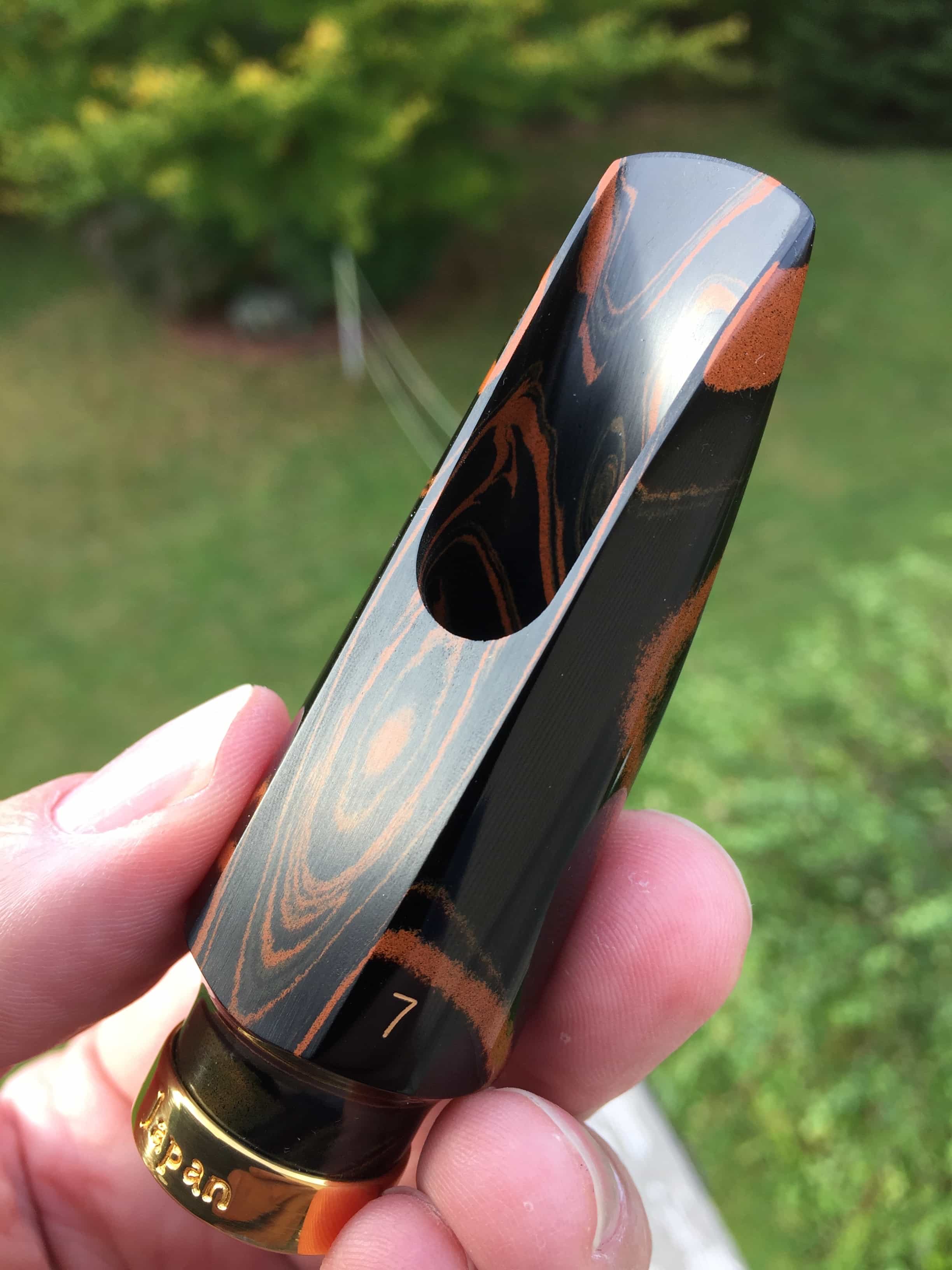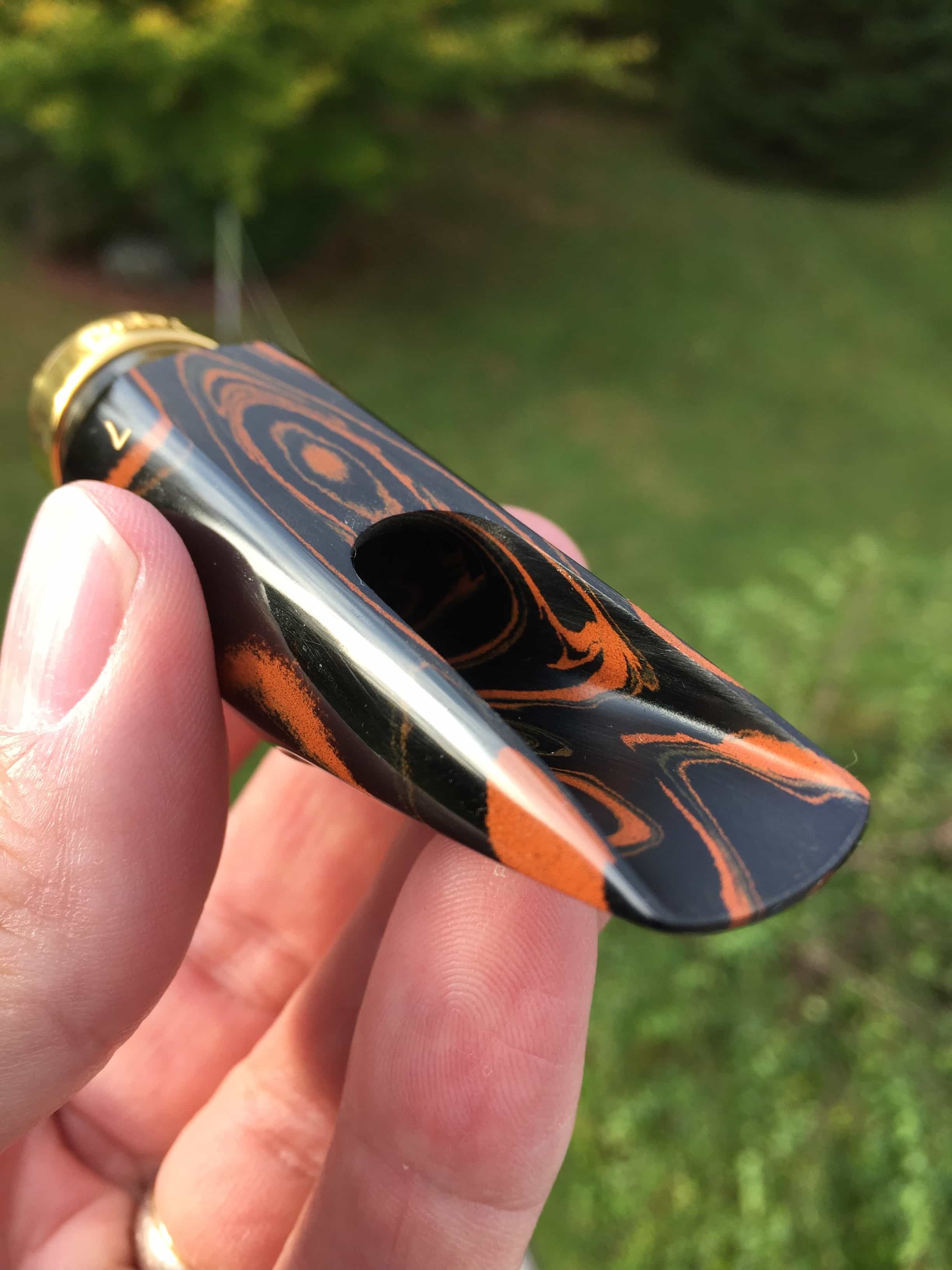If you like the sound of Paul Desmond, this review is for you. Today, I am reviewing a hard rubber alto saxophone mouthpiece from Gottsu mouthpieces in Japan. I had received some emails from a few different fans of my site who were impressed with the Gottsu sax mouthpieces they had played and I decided to reach out to the Gottsu company and see if I could review some of their mouthpieces. In response, they sent me a beautiful Gottsu Sepia Tone Jazz Metal Tenor saxophone mouthpiece to review which I loved!
Gottsu recently sent me two more saxophone mouthpieces to review. They are the hard rubber Gottsu Sepia Tone VI Marble tenor mouthpiece that I already reviewed and a Gottsu Sepia Tone VI alto saxophone mouthpieces that I am reviewing today.
Gottsu Sepia Tone VI Marble Alto Saxophone Mouthpiece
The Gottsu Sepia Tone VI marble alto saxophone mouthpiece I received is beautiful as you can see in the photos. It is made of hard rubber with a colored marble design to it. It is a 7 tip opening which according to the tip opening chart on the Gottsu mouthpiece website is a .075 tip opening.
The Gottsu VI alto sax mouthpiece really is a work of art. The craftsmanship looks amazing. The saxophone mouthpiece has “Gottsu VI” engraved on the top and “Sepia Tone” engraved on the gold band of the shank. Japan is engraved on the bottom of the gold band and the tip opening of 7 is engraved on the right side of the mouthpiece as you look at the table.
Gottsu Sepia Tone VI Marble Alto Saxophone Mouthpiece
The table, tip rail, side rails and baffle of the mouthpiece look great to the eye. The tip rail looks thin, even and balanced. The tip rail lines up with the shape of the saxophone reed tip nicely.
The baffle is a rollover baffle that is a medium-low baffle height. The baffle looks pretty flat between the tip and the rollover. After the rollover, the baffle has a scooped side to side curve to it that looks to follow the whole length of the baffle until it terminates at the end of the mouthpiece chamber similar to how the baffle looked in the Gottsu metal jazz mouthpiece review.
The chamber looks a little smaller in size than a hard rubber Meyer chamber. I don’t have a Meyer alto mouthpiece here to compare but it does seem smaller to me as I look at it. I would describe the chamber size as between medium and small. The chamber looks to be the same size as the bore of the mouthpiece.
The inside of the side rails look and feel pretty straight to me. There is a smooth transition where they meet the chamber and expand slightly to round out the chamber. The roof of the mouthpiece chamber is not thin but has a bit of thickness to it.
Gottsu Sepia Tone VI Marble Alto Saxophone Mouthpiece
The Gottsu Sepia Tone VI marble alto sax mouthpiece is similar in size and diameter to a typical hard rubber Meyer alto saxophone mouthpiece and I used a Vandoren Optimum ligature that I use on hard rubber Meyer mouthpieces on the Gottsu VI marble alto saxophone mouthpiece. The beak profile also feels very comfortable and similar in shape to the beak profile on a hard rubber Meyer alto saxophone mouthpiece.
Gottsu Sepia Tone VI Marble Alto Saxophone Mouthpiece
Here is a quote from the Gottsu mouthpiece website on the Sepia Tone VI marble alto saxophone mouthpiece:
Sepia Tone VI Marble
Baritone / Tenor / Alto
Mellow, deep and dynamic sounds
The VI mouthpiece is made by a jazz man for jazz lovers. This mouthpiece is made from the same ebonite used in the making of the Gottsu Sepia Tone line. The defining feature of the VI mouthpiece is a vintage jazz sound. But unlike the Gottsu Sepia Jazz Metal, the VI fits larger in the mouth and offers a more mellow tone. One of the most important things for any musician is to search for one’s own sound, and though this process may take many years, the VI mouthpiece will continue to work well every step of the way. I promise that this work of art will give you immense joy. Please enjoy discovering the diverse possibilities of music.
Gottsu Original Technology +R
+R (advanced process) is the most advanced G-Tune technology for processing the tip rail for a more efficient reed vibration. With this special processing, the reed vibrates effectively to create a smooth sensual tone like no other. Gottsu’s original design methods allow one to play exquisitely from the first note–making it much easier to reach lower notes and give an overall pleasant feel throughout the range of the horn.
Featuring a flat surface table, facing curve, side rail, each piece is meticulously hand-crafted all the way to the tip rail. Made from our newly introduced hard rubber and with our original adjusting methods (G-Tune +R), the Gottsu Hard Rubber Sepia Tone was born. We’ve recreated the sound from the good ol’ days. Striving to achieve ultimate ease of emission in playing, we’ve reached a beautiful outline and outstanding tone quality; a sound that is rich with a sweet and charming shimmer.
Gottsu Sepia Tone VI Marble Alto Saxophone Mouthpiece
The Gottsu Sepia Tone VI marble alto saxophone mouthpiece played well for me with a Rigotti Gold 3 light, 3 medium and Lupifaro Evo 3 saxophone reeds.
I would best describe the tone as a light, bright “Desmondish” kind of alto saxophone tone. The word “Desmondish” is obviously referring to Paul Desmond who had one of the most beautiful light signature alto saxophone tones of all time. (Listen to Take Five by Paul Desmond and Dave Brubeck as an example).
The intonation on the Gottsu Sepia Tone VI alto saxophone mouthpiece was excellent. The mouthpiece articulated well also and was smooth and even throughout the range of the horn.
Gottsu Sepia Tone VI Marble Alto Saxophone Mouthpiece
I have provided one sound clip below of me playing the Gottsu Sepia Tone VI alto saxophone mouthpiece with a Lupifaro Evo #3 alto sax reed. I try to play in a few different styles and using a variety of lines throughout the range of the horn.
I did feel like the strength of the Gottsu VI alto sax mouthpiece in leaning towards that “Desmondish” sound concept could also be considered a weakness if you don’t prefer that sound. In my opinion, this is a great mouthpiece if that is the sound you want but I wouldn’t classify it as a versatile mouthpiece with a wide range of tones. The whole time I was playing the Gottsu VI alto sax mouthpiece, I felt like it was pulling me towards that Desmondish sound and it was hard for me to escape it. Again, this is a great benefit if that is the sound that you want on the alto saxophone!
Gottsu Sepia Tone VI Marble Alto Saxophone Mouthpiece
If you like the sound and look of the Gottsu Sepia Tone VI marble alto saxophone mouthpiece, you can find more information about them on the Gottsu website. They also have provided additional sound clips as well as a list of stores where you can purchase Gottsu saxophone mouthpieces.
I just want to thank and commend Masahiko Goto at the Gottsu company for doing a great job on this Gottsu Sepia Tone VI marble alto saxophone mouthpiece and for sending it to me to try out for this review. It really is a well crafted and beautiful saxophone mouthpiece that plays exceptionally well.
If you have played or end up playing a Gottsu Sepia Tone VI marble alto saxophone mouthpiece or have any other thoughts or comments about this review, I would love to hear what you think in the comments below. Thanks, Steve
Gottsu Sepia Tone VI Marble Alto Saxophone Mouthpiece-Lupifaro Evo 3 Reed










Wow, Desmondish is spot on! As I listened, it felt like I was listening to Skylark! It is visually beautiful, too. Thank you for your wonderful reviews, I feel that your analysis and playing of the pieces are the most valuable to me on the internet!
That’s really nice. It really reminds me of Desmond but sounds agile and capable of power and brightness if need be.
Wonderful and useful review! Thank you Steve!
I hope you get the chance to review the Gottsu Sepia Tone alto mouthpiece, which is just so much more versatile than the VI model.
Interesting, I did not know that. Is it more like a Meyer or something else?
Yes, it’s like a Meyer only slightly brighter. I bought the VI as I liked the original mouthpiece so much, but sold it on as it was too dark for me. I suspect most people would far prefer the original Sepia Tone model.
That’s good to know. I’m not even sure if they are sending mouthpieces out right now with the pandemic but I’ll reach out to them and ask.
Hopefully they send you one. The tip openings are not what you would expect. The 8 is 0.83, more like a 7 to me.
Do you have an 8? I usually like around .080 on alto and have found .083 to feel too large in the past. You think it feels smaller?
I moved up to the 8 from the 7 which felt smaller. They number the tip openings differently from say Otto Link where a 7 is 0.85.
Is the Gottsu Sepia Tone VI Marble Alto Saxophone Mouthpiece a free blowing mouthpiece?
No it isn’t. But what do you mean by “free blowing”? I am not a big fan of mouthpieces that I have felt are free blowing. I feel like they are one dimensional and I can’t shape the sound easily. I blow 50% of my air and the mouthpiece is at 100% volume because it is so free blowing. I don’t really like that feeling. The most free blowing mouthpiece I ever payed was a Jodyjazz ESP tenor mouthpiece I think. I used it for about 6 months about 20 years ago and although I usually used 2 1/2 or 3 reeds on 8 tip opening tenor mouthpieces, I had to use a 4 and sometimes 4 1/2 size reed on the ESP. I really loved it at first cause I could really wail on it but soon realized that it only had that one sound to it and I wanted more dimensions and options for my sound than I could get with that mouthpiece.
The Gottsu has some resistance to it just like most of the other mouthpieces I have reviewed. I think it has a little bit more resistance to blow against which is what gives it that Desmondish refined sound in my opinion. I think if you got rid of the resistance you would lose the refined tone it gets also. I hope this answers your question. Steve